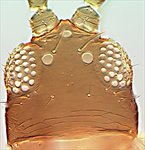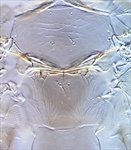Generic diagnosis
Female macropterous. Head wider than long, prolonged anteriorly; maxillary palps 3-segmented; eyes without pigmented facets; ocellar setae I absent; setae II small; five pairs of postocular setae. Antennae 7-segmented; segment I with median dorso-apical setae; III much smaller than IV, III and IV with sense-cone forked, III–VI with some rows microtrichia on both surfaces. Pronotum wider than long; two pairs of posteroangular setae; three pairs of posteromarginal setae. Mesonotum median pair of setae far from posterior margin; campaniform sensilla present. Metanotum weakly reticulate; median pair of setae far from anterior margin; campaniform sensilla absent. Fore wings narrow; first vein without long gap in setal row; second vein with many evenly spaced setae; clavus with five or six veinal and one discal setae; posteromarginal fringe cilia wavy. Prosternal ferna not divided; basantra membranous, without setae. Mesosternum with sternopleural sutures reaching anterior margin; endofurca with spinula weak. Metasternal endofurca without spinula. Tarsi 2-segmented. Tergites without ctenidia or craspeda, tergite V often with weak ctenidium-like microtrichial row; VIII posterior margin with a few microtrichia at each side; IX with major setae elongate, two pairs campaniform sensilla present; X almost as long as IX, with complete median split, and major setae elongate. Sternites without craspeda or discal stae; III–VII with three pairs of posteromarginal setae, II with two pairs. Ovipositor weak, without marginal serrations.
Male similar to female; antennal segment III very small, III–VI elongate with many elongate setae; tergite IX posterior margin with pair of horn-like processes; sternites III and IV each with a pair of small pore plates.
Biological data
The species in this genus breed on Poaceae, but with no recorded species-level specificity. The extreme reduction of the ovipositor possibly indicates that the females deposit eggs in the florets of grasses rather than insert the eggs into the plant tissues as is normal in Thripidae.
Distribution data
This genus is from the New World, with most species being from the Neotropics (Mound et al., 2016), although perplexus is widely distributed around the world in tropical countries.
Nomenclatural data
Plesiothrips Hood, 1915: 129. Type species Sericothrips perplexa Beach 1897, by monotypy.
There are 17 species placed in this genus (ThripsWiki, 2020), but only one is recorded from China:
perplexus (Beach, 1896: 216). (Sericothrips)
Relationship data
Thripidae sub-family Thripinae: this is a diverse group involving more than 230 genera. Despite being primarily Neotropical in distribution, this genus is possibly related to the Trichromothrips genus-group that is distributed mainly in the Old World tropics (Mound et al., 2016). These genera share the presence of a pair of dorso-apical setae on the first antennal segment, and the males have sternal pore plates in pairs instead of a single plate placed medially.
References
Mound L, Lima E, O’Donnell C & Cavalleri A (2016) New World grass thrips of the genus Plesiothrips (Thysanoptera: Thripidae). Austral Entomology 55: 340–346.
ThripsWiki (2020). ThripsWiki - providing information on the World's thrips. <http://thrips.info/wiki/Main_Page>



